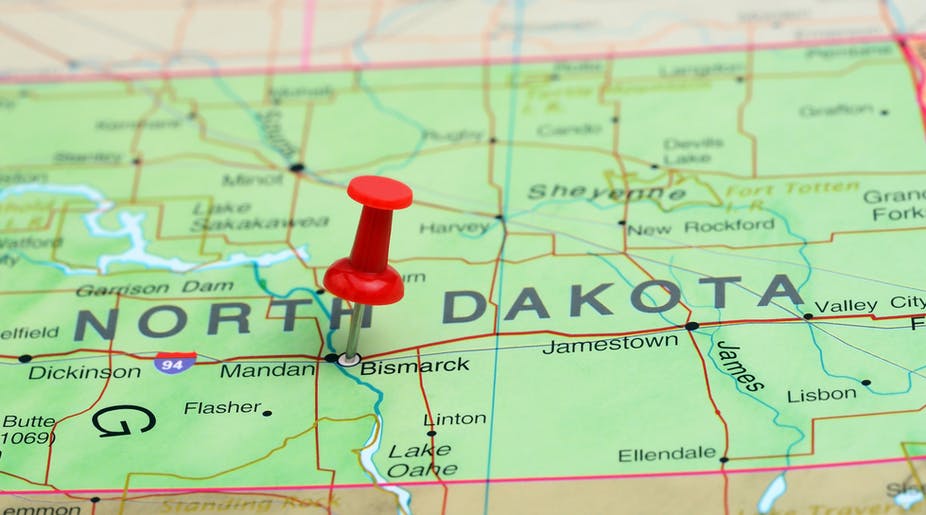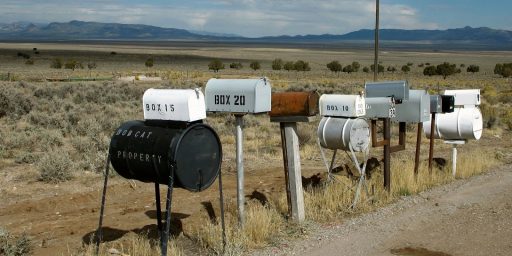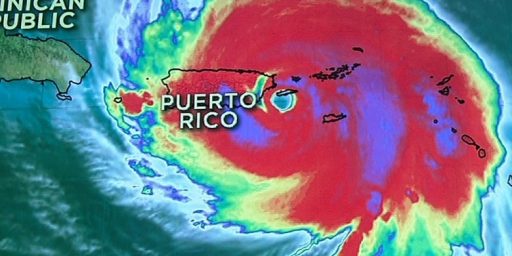The Senate’s Rural Skew
Injecting data into the conversation.

That the Senate has a skew toward rural voters, and therefore the Republican Party, is hardly a secret. Indeed, it’s been the premise of many recent OTB posts. And interesting essay by FiveThirtyEight’s Nate Silver demonstrates precisely how big that skew is.
First, his coding definitions:
At FiveThirtyEight, our favorite way to distinguish between urban and rural areas is based on using census tracts to estimate how many people live within a 5-mile radius of you. Based on this, we can break every person in the country down into four buckets:
*Rural: Less than 25,000 people live within a 5-mile radius of you;
*Exurban or small town: Between 25,000 and 100,000 people within a 5-mile radius;
*Suburban or small city: Between 100,000 and 250,000 people within a 5-mile radius;
*Urban core or large city: More than 250,000 people within a 5-mile radius.
As it happens, the overall U.S. population (including Washington D.C. and Puerto Rico) is split almost exactly evenly between these buckets: 25 percent rural, 23 percent exurban/small town, 27 percent suburban/small city, and 25 percent urban core/large city.
While one could certainly quibble with those definitions, they strike me as perfectly reasonable starting points. Crucially, while the overall American population is almost evenly divided into those four categories, the average American state is not. Indeed, 17 states have no big cities at all and another 10 have less than ten percent of their population living in them.
Here’s how that breaks down:
|
State |
Rural |
Exurban /Small Town |
Suburban /Small City |
Urban Core /Big City |
|---|---|---|---|---|
|
U.S. population total* |
25% |
23% |
27% |
25% |
|
Average state |
35 |
26 |
25 |
14 |
|
State |
Rural |
Exurban /Small Town |
Suburban /Small City |
Urban Core /Big City |
|
Alaska |
53% |
18% |
28% |
0% |
|
Alabama |
51 |
33 |
16 |
0 |
|
Arkansas |
58 |
36 |
6 |
0 |
|
Arizona |
17 |
19 |
29 |
35 |
|
California |
8 |
13 |
26 |
54 |
|
Colorado |
21 |
18 |
30 |
31 |
|
Connecticut |
8 |
35 |
45 |
11 |
|
Delaware |
24 |
27 |
49 |
0 |
|
Florida |
13 |
27 |
35 |
26 |
|
Georgia |
31 |
29 |
32 |
7 |
|
Hawaii |
23 |
22 |
35 |
19 |
|
Iowa |
52 |
29 |
19 |
0 |
|
Idaho |
42 |
36 |
22 |
0 |
|
Illinois |
19 |
15 |
28 |
38 |
|
Indiana |
37 |
27 |
33 |
2 |
|
Kansas |
41 |
25 |
31 |
3 |
|
Kentucky |
52 |
20 |
23 |
5 |
|
Louisiana |
41 |
30 |
20 |
9 |
|
Massachusetts |
6 |
32 |
35 |
27 |
|
Maryland |
13 |
22 |
29 |
36 |
|
Maine |
69 |
25 |
6 |
0 |
|
Michigan |
30 |
23 |
28 |
19 |
|
Minnesota |
36 |
19 |
25 |
20 |
|
Missouri |
41 |
19 |
31 |
9 |
|
Mississippi |
65 |
29 |
6 |
0 |
|
Montana |
59 |
41 |
1 |
0 |
|
North Carolina |
37 |
36 |
25 |
1 |
|
North Dakota |
49 |
39 |
12 |
0 |
|
Nebraska |
36 |
17 |
39 |
8 |
|
New Hampshire |
39 |
42 |
18 |
0 |
|
New Jersey |
5 |
18 |
33 |
44 |
|
New Mexico |
41 |
28 |
26 |
5 |
|
Nevada |
13 |
9 |
25 |
53 |
|
New York |
14 |
14 |
15 |
57 |
|
Ohio |
26 |
29 |
33 |
12 |
|
Oklahoma |
44 |
23 |
32 |
1 |
|
Oregon |
29 |
21 |
24 |
26 |
|
Pennsylvania |
23 |
31 |
25 |
21 |
|
Rhode Island |
8 |
31 |
22 |
39 |
|
South Carolina |
40 |
41 |
18 |
0 |
|
South Dakota |
65 |
19 |
16 |
0 |
|
Tennessee |
41 |
31 |
28 |
0 |
|
Texas |
21 |
17 |
34 |
27 |
|
Utah |
21 |
19 |
41 |
19 |
|
Virginia |
28 |
22 |
34 |
17 |
|
Vermont |
79 |
21 |
0 |
0 |
|
Washington |
20 |
22 |
39 |
19 |
|
Wisconsin |
41 |
27 |
19 |
13 |
|
West Virginia |
64 |
36 |
0 |
0 |
|
Wyoming |
66 |
34 |
0 |
0 |
So, functionally, what does that mean?
It means that the Senate, de facto, has two or three times as much rural representation as urban core representation … even though there are actually about an equal number of voters in each bucket nationwide.
And of course, this has all sorts of other downstream consequences. Since rural areas tend to be whiter, it means the Senate represents a whiter population, too. In the U.S. as a whole, 60 percent of the population is non-Hispanic white and 40 percent of the population is nonwhite.1 But in the average state, 68 percent of people are white and 32 percent are nonwhite. It’s almost as if the Senate has turned the clock back by 20 years as far as the racial demographics of the country goes. (In 2000, around 69 percent of the U.S. population consisted of non-Hispanic whites.)
It also means that the median states — the ones that would be decisive in the event of a 50-50 tie in the Senate — are considerably redder than the country as a whole.
The standard response to this is that it’s baked into the cake. Why, it’s what the Framers wanted. But that’s simply untrue. Not only did “the Framers” have no uniform preference on this—a Senate with equal representation was a compromise liked by virtually none of them—but there wasn’t anything like that sort of skew in 1787 when the compromise was arrived at.

Beyond that, the Framers quite bizarrely failed to account for the rise of political parties. And, again, the skew is decidedly partisan in its impact.
A red state is most likely to decide the Senate
Republican margin or deficit in the last two presidential elections relative to national average by state and a blended average (representing current partisan lean)
| Rank | State | 2016 | 2012 | Blended* |
|---|---|---|---|---|
| 1 | Wyoming | +48.4 | +44.7 | +47.5 |
| 2 | West Virginia | +43.8 | +30.5 | +40.5 |
| 3 | Oklahoma | +38.5 | +37.4 | +38.2 |
| 4 | Idaho | +33.9 | +35.5 | +34.3 |
| 5 | North Dakota | +37.8 | +23.5 | +34.2 |
| 6 | Kentucky | +31.9 | +26.5 | +30.6 |
| 7 | South Dakota | +31.9 | +21.9 | +29.4 |
| 8 | Alabama | +29.8 | +26.0 | +28.9 |
| 9 | Arkansas | +29.0 | +27.5 | +28.6 |
| 10 | Utah | +20.0 | +51.7 | +27.9 |
| 11 | Tennessee | +28.1 | +24.2 | +27.1 |
| 12 | Nebraska | +27.1 | +25.6 | +26.8 |
| 13 | Kansas | +22.5 | +25.4 | +23.2 |
| 14 | Louisiana | +21.7 | +21.1 | +21.6 |
| 15 | Montana | +22.3 | +17.5 | +21.1 |
| 16 | Indiana | +21.1 | +14.1 | +19.3 |
| 17 | Mississippi | +19.9 | +15.4 | +18.8 |
| 18 | Missouri | +20.6 | +13.2 | +18.8 |
| 19 | Alaska | +16.8 | +17.8 | +17.1 |
| 20 | South Carolina | +16.4 | +14.3 | +15.9 |
| 21 | Texas | +11.1 | +19.6 | +13.2 |
| 22 | Georgia | +7.2 | +11.7 | +8.3 |
| 23 | Iowa | +11.5 | -2.0 | +8.1 |
| 24 | Ohio | +10.2 | +0.9 | +7.8 |
| 25 | Arizona | +5.6 | +12.9 | +7.4 |
| MEDIAN | +6.6 | |||
| 26 | North Carolina | +5.7 | +5.9 | +5.8 |
| 27 | Florida | +3.3 | +3.0 | +3.2 |
| 28 | Pennsylvania | +2.8 | -1.5 | +1.7 |
| 29 | Wisconsin | +2.9 | -3.1 | +1.4 |
| 30 | New Hampshire | +1.7 | -1.7 | +0.9 |
| 31 | Michigan | +2.3 | -5.6 | +0.3 |
| 32 | Minnesota | +0.6 | -3.8 | -0.5 |
| 33 | Nevada | -0.3 | -2.8 | -1.0 |
| 34 | Virginia | -3.2 | -0.0 | -2.4 |
| 35 | Colorado | -2.8 | -1.5 | -2.5 |
| 36 | Maine | -0.9 | -11.4 | -3.5 |
| 37 | New Mexico | -6.1 | -6.3 | -6.2 |
| 38 | Oregon | -8.9 | -8.2 | -8.7 |
| 39 | Delaware | -9.3 | -14.8 | -10.7 |
| 40 | Connecticut | -11.5 | -13.5 | -12.0 |
| 41 | New Jersey | -11.9 | -13.9 | -12.4 |
| 42 | Washington | -13.6 | -10.9 | -12.9 |
| 43 | Illinois | -14.8 | -13.0 | -14.3 |
| 44 | Rhode Island | -13.4 | -23.6 | -16.0 |
| 45 | New York | -20.4 | -24.3 | -21.4 |
| 46 | Massachusetts | -25.1 | -19.3 | -23.7 |
| 47 | Maryland | -24.3 | -22.2 | -23.8 |
| 48 | California | -27.9 | -19.2 | -25.7 |
| 49 | Vermont | -24.3 | -31.7 | -26.2 |
| 50 | Hawaii | -30.1 | -38.8 | -32.3 |
Now, I suppose, one could argue that the alignment of rural and partisan interests isn’t set in stone. Maybe the Democrats should do more to court the votes of rural voters.
Still, it’s not by any means obvious why rural voters deserve outsized representation. And, even aside from the partisan skew that creates, the fact that it disproportionately advantages white voters is itself highly problematic.
What to do about any of this is far from obvious. Amending the Constitution to fix the problem is next to impossible, precisely because those who benefit most from it not only have a strong disincentive to vote against their own interests but, of course, they have an outsized share of the vote.
Silver notes that even radical solutions only move the needle so much:
Democrats could also consider adding states to the union. If both Washington D.C. and Puerto Rico became solidly Democratic states (not necessarily a safe assumption in the case of Puerto Rico), the Senate’s Republican lean would be reduced from 6.6 points to 4.5 points. If D.C. and Puerto Rico joined and California were split into three states that ranged from Democratic-leaning to solidly blue, it would deplete further to 2.5 points. But that also goes to show you how robust the Republicans’ advantage is. You could add four Democartic states (D.C., Puerto Rico, California/A and California/B) and the Senate would still have a slight Republican tilt.
Again, the caveat is important:
Obviously, political coalitions can change over time. Maybe you’re reading this article in 2036 and it seems incredibly silly because Mormons have become a super Democratic group and Montana, Utah and Idaho are all blue states … who knows.
Indeed, when I was first paying attention to this thing, the conventional wisdom was that the Republicans had a “lock” on the Electoral College, mostly because California was squarely in its corner, but the majorities in Congress were practically the Democrats’ birthright. When Newt Gingrich and the Republicans took the majority in the House pursuant to the 1994 elections, it was the first time in four decades that the GOP had control of that body.
The Senate has been slightly more fluid but Democrats took control riding FDR’s coattails in 1933 with the 73rd Congress and held it for all but two terms* until the 97th Congress rode in on Ronald Reagan’s coattails in 1981. But, even though we were seeing a realignment, Democrats have held the Senate multiple times since then. They regained control with the 100th Congress (1987-1989); the Republicans took it back with the 104th Congress (1995-1997); we briefly had a 50-50 Senate with the 107th Congress (2001-2003); Republicans took it back with the 108th Congress (2003-2005); Democrats took it back with the 110th Congress (2007-2009); and the Republicans have had it since the 114th Congress (2015-2017).
The Democrats appear poised to take it back with November’s elections. But, to Silver’s point, even wave elections in the Democrats’ favor aren’t always enough. And, certainly, the built-in advantage caused by over-representation of rural districts is part of the reason.
*The 80th Congress (1947-1949) and the 83rd Congress (1953-1955).





Precisely, the GOP, as currently constituted, begins every race with a 6 or 7 yard head start on a 100 yard sprint. And if their strategy is to be the anti-urban party and tarring any local Democrat as having New York or San Francisco values no matter what local values are held, this is one hell of an advantage that will only get blown after massive and epic mismanagement (KAt?RINA, SS privatization attempt, COVID clusterfuck)
If there was a strong line of conservative technocratic competence, it would be extremely tough for the GOP to lose as they only need to avoid systetmically shooting themselves in the foot while the Democrats, under current configurations, need to have large national waves to have a chance at the Senate (and even then, depending on the year D+7 or D+8 is not enough nationally to gain contested net seats).
That is not a fundamentally sustainable equilibirum.
Your illustration takes me back. I was born in a hospital in Bismarck, where the pin is stuck, and raised through grade school in Rugby, the blurred name above the pin.
Funny how so many of those same people don’t mind voting for politicians who are against those peoples’ own interests…
As a Californian, I would very much like people to stop proposing to split our state into multiple parts. It’s not going to happen and it should not happen.
@Kari Q:
I’m a lifelong Californinan, and would LOVE the state broken up into three states.
Southern California, encompassing San Luis Obisbo, Santa Maria, Santa Barbara, Ventura, Los Angeles, San Diego with the everything west of the 5 Fwy and south of the 40/58.
Bakersfield and Fresno would go to Central California, along with everything east of the 5 Fwy, all the way up to Sacramento. Everything south of Fwy 80 and east of the 5 fwy is Central California.
Northern California would encompass Monterey, San Jose, San Francisco, Oakland. and all the land from north of Fwy 80 and west of the 5 Fwy from San Luis Obispo.
Central California would soon become like Alabama or Mississppi, but it’s what they want, so let them have it. Northern and Southern California would be fine.
Won’t matter to me as I’ll be in Hawaii or Ecuador by then.
We’re seeing the same mess that occurred in Georgian England (rotten boroughs) and post-WWII Japan.
I’d prefer it if states could decide on their own whether to split up, so they could decide whether to bank on extra political clout or economic clout.
Common reforms are fundamentally conservative, in that they tend to change as little as possible. Even that is hard, so changing in a more radical way is almost impossible.
A decent Senate reform would reapportion seats in proportion to population, much like the House, limiting the total seats to 100 or maybe a few more. I don’t see how else to make it representative. Oh, small states would be guaranteed one senator at least, which would still give them outsize representation.
That’s radical enough. We can make it more radical by making the Senate about equal to the House: hundreds of seats, apportioned by population, but with six-year terms.
Or go all out and abolish the Senate. Increase the size of the House, change the terms to four years (half standing for reelection at two year intervals), and transfer all Senate-specific duties to the House.
@Kari Q:
@EddieInCA:
There are already three states named California. Two are in Mexico: Baja California and Baja California Sur.
@EddieInCA:
Seriously? Pasadena, Arcadia and the rest of the San Gabriel valley is Mississippi? El Monte?
Looking at the ethnicity, could be some disgruntlement.
Rather than play nice with the rural states, what if the Dems played hardball instead? No water projects passed without square state support of Dem initiatives. No farm bills that benefit corporations. Etc.
@charon:
I don’t see any edit function here at all now.
@charon:
Pasadena, El Monte, Arcadia and the rest of the San Gabriel Valley, as well as all of Riverside, Palm Springs, and San Bernardino. They’re all SOUTH of the 40 and 58.
You weren’t paying attention, my friend.
Crap. Can’t edit. Missed the words “are all part of Southern California.” after “San Bernardino”.
@charon:
BTW, when I was late teens, early 20’s, all the best parties were in Pico Rivera, El Monte, and Whittier. And, of course, cruising Whittier Boulevard on Saturday nights was the thing to do.
If the solutions available to majoritarians, such as the expansion of states, end with outcomes remaining skewed slightly to minority control, then they’re not really “radical.”
I’m not sure I agree with how they’ve defined “rural” which is far different from how the Census defines it.
For those who want to calculate where they live or any other area in the country, here is a handy mapping tool:
https://sedac.ciesin.columbia.edu/mapping/popest/pes-v3/
Fun fact: In 1790 only 5% of Americans lived in a city.
Looking over the table, I see many states with no “big cities.” My guess is that many it calls “small cities” are really pretty urban.
@Andy:
Hope you’re well. Miss you around here, buddy.
@Andy: Unfortunately, in 1990, 2000, and 2010 the Census Bureau used a different definition for rural each time. That made it difficult to do any detailed comparisons over time. This definition is at least a reasonable starting point. It catches some of the same things that the CB’s numbers catch — eg, the West and Northeast urban corridor dominate an “urban plus suburban percentage” category. To Prof Joyner’s point, if you use my 13-state West, 12-state-plus-DC Northeast urban corridor, and 25-state Rest, and ignore the oddities, Clinton’s EC votes in 2016 were 104 from the urban corridor, 98 from the West, and 30 from the Rest. It also suggests the strategy I’ve recommended for Biden: just win Arizona and Florida, baby.
@charon: Having been through a number of them, I suspect that most people would find that the biggest city in the state did indeed feel like a big suburb with a rather modest business downtown tacked on. In particular, housing dominated by detached single-family houses.
@Michael Cain:
Setting aside my very big city prejudice, under which most cities are overgrown villages to me, I’d argue “city” is defined by a certain style, or mix of styles, that are common to most of them regardless of size.
For instance, there’s limited greenery so as not to obstruct the view of storefronts or even the fronts of office buildings from view of people driving. So no leafy canopies by the curb, though there may be a few trees planted on the sidewalk or at medians or roundabouts.
While I’ve visited several places in the US, I’ve really known few cities. For example, when we visited San Antonio or Houston, we kept mostly to the large malls in the suburbs (can you believe six or so trips to San Antonio and not one visit to the Alamo?).
But I’ve also visited NYC, specifically Manhattan, which is the epitome of modern cities (along with several others), Las Vegas*, and Miami.
*Trivia: what most people think of as Las Vegas, meaning mostly the Strip along las Vegas Blvd., is located in the unincorporated town of Paradise, Nevada. The real city of Las Vegas is farther north, about, if memory serves, where the Stratosphere hotel is. Downtown, my favorite place, is well within City limits.
Over at Vox there was (gone from face page now, I had to search a bit) a rather lengthy article by Matthew Yglesias quoting the same 538 calculations that demonstrates how minority power has been used to lock in greater minority power. Well worth reading! He says that the R-party advantage is worth 2-3% of votes in the Electoral College, 4% in the House and 6-7% in the Senate.
http://www.vox.com/21448334/republicans-supreme-court-ginzberg-democracy
Please. This is the whole point of the structure of our government.
Further, just look at a county by county map of the US. Its a sea of red. Only the major cities, broke, lawless and profoundly silly keep the Democrat party alive. “Send your money to government, we will give back what we deem necessary. We hope you understand the skim………..heh.”
@EddieInCA:
I can disrupt that plan with one word: water.
So let’s stop the silliness. Not happening.
@keef:
Without the cities this country is a large Bulgaria.
All the business, all the money, all the creatives, all the tech, all the universities, all the research institutes, all the great hospitals, all the museums, all the airports.
So STFU goober.
@EddieInCA:
Can we give them Huntington Beach and take Tahoe?
@keef:
Shorter keef: One acre, one vote.
Only the major cities, broke, lawless and profoundly silly keep the Democrat party alive.
Until you get to the urban/inner suburban West, now heavily Democratic, where “urban problems” means almost unmanageable growth in population and jobs. I assert this is one of the big problems facing the party: urban problems in the South and the West means huge growth vs the Midwest and much of the Northeast, where urban problems means contracting jobs and population. Somehow those have to be reconciled.
@Michael Reynolds:
Yes.
@Kathy:
Oh yeah, the Alamo! I always forget the Alamo….
@keef:
Real estate doesn’t matter. People do. You are letting one specific graphical representation drive your understanding.
@Steven L. Taylor:…@keef:..Real estate doesn’t matter. People do.
“Only the major cities, broke, lawless and profoundly silly…”
I’d say keef’s mind is made up about people in cities.
Mixed up in the rural skew of the Senate is this issue of two Americas…sadly, Obama was wrong about there being one United States of America…just as Republicans/conservatives complain about how the “coastal elites” belittle flyover country and the people who live there, it is quite obvious how people like keef (many of those people who live in flyover country) also have a deep contempt for big cities and the people who live in them…until this urban/rural divide can be fixed, we’ll remain in a state of permanent gridlock…
@keef:
I’ve been thinking a lot about trying to get a referendum on that ballot in Washington that will mandate that at least 80% of the state tax revenues in a county be spent in that county. It sounds like a very right wing thing, doesn’t it? Keep taxes local.
It would also devastate Eastern Washington. The rural areas are a huge drain on the state — its the cities that generate the wealth, which is why people want to live there. There’s not a whole lot of opportunity in rural areas, unless you want to work at the Wal-Mart or the tractor parts store.
I’m way too lazy to figure out how to get something on the state ballot. Plus, I fear it would pass and hurt a lot of people. I’d really just like to make people in the rest of the state have to confront some of the basic lies they have been told — that their tax money is all going to Seattle, for instance.
@Michael Cain:
So just Phoenix, Houston, or L.A., on a smaller scale, which is how I experienced Tulsa.
The difference is the bigger cities have satellite “edge cities” like the Galleria and Greenway Plaza in Houston or Century City in L.A.
@Kathy:
Or perhaps maintain the Senate as it was, but transfer its specific powers (voting in international treaties and presidential appointees, I think) to the House (remaining the Senate only with a kind of veto power over the House decisions in legislation and budgets)? Nothing of this will happen, of course.
Many other democratic countries have an upper house distorted in favor of the less populous regions (and sometimes even indirectly elected, by the local governments), but with less power than the lower house, elected by “one person, one vote”; I think the USA peculiarity is that the upper house has more power than the lower.
@Michael Reynolds:
That overstates things a mite. Many of our great universities are far from the urban core as defined here or, indeed, anything either of us would consider a big city. I don’t think even Silicon Valley would qualify. But the larger point is certainly true: rural areas feed us but it’s places people cluster that advance us as a civilization.
@James Joyner:
Santa Clara County (Silicon Valley) has 1+ million people in it.
Think before speaking is a good thing.
@DAVID M Anderson:
This means 1.400 people by square mile (according to wikipedia); I could be wrong, but I think that “within a 5-mile radius of you” is 79 square miles (PI*5^2); then 110.600 people “within a 5-mile radius of you” – “suburban or small city” (100,000 – 250,000 people), bordering the “exurban or small town” (25,000 – 100,000 people)
@James Joyner: @DAVID M Anderson:
Not to mention:
Manhattan hangs its head in shame.
Merely observing the PVI of the median Senate seat considerably understates the challenge Democrats face long-term. Because the seats are staggered they don’t just need to win one cycle by 6/7 points (hard but not impossible given a recession or similar) but average a margin that high over the course of three cycles, at least of which necessarily will not be that favorable. 2016/2018/2020 (assuming polls are accurate) is ideal: a positive national environment that still resulted in a Republican Presidency in 16, following by a historic wave in 18 and then a landslide Presidential win in 20. Most six-year cycles will not look like that and the divergence between the median seat and the median voter will only grow over time. If Democrats do not get a trifecta in 2020 and use it change the rules unilaterally they are unlikely to ever get another chance, that and not “norms” is the case for procedural escalation on the left
misplaced the italic which should be around “necessarily.”
Oh, more than that. Food, sure, but also the electricity your life depends on. And then there is the heavy and medium industry, as well as increasingly, light industry as urban land prices force high sqft/employee manufacturing out of cities.
Cities excel where you need a lot of bodies to see a lot of different aspects of humans frequently. Obviously, the top hospitals would be where they had a plentiful supply of diverse ailments. There’s a reason the Army sent surgeons to work urban trauma ERs where they had frequent gunshot wounds in the ’80s as we were between wars.
But that is all in flux now was people have fled urban densities. All those bodies mixing are also excellent places for disease and viruses. The Heritage Foundation has a report out. Forty-nine percent of COVID-19 deaths came from just 1.6% of counties (50 counties) but who had 25.4% of the population. Fifty percent of US counties has 10 or fewer deaths (1.6% of deaths) from COVID-19 representing 12.5% of the population.
With COVID-19, we see the damage that can be done when the dense urban populations control the politicians. The damage is inflicted on the more rural precincts as the urbanistas can’t fathom a reality outside their urban experience.
@Kurtz:
Thank you! I’m dipping my toes back in – we’ll see how it goes.